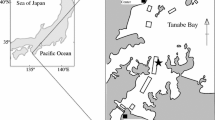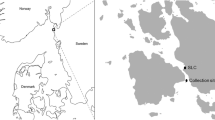Abstract
We studied the role of oval faecal pellets in the carbon-cycle dynamics of the Antarctic coastal area in a laboratory experiment on pellet degradation over time. We observed a rapid increase in the bacterial biomass until 56 h (from 14.73 to 91.09 µgC/l), but a drop to 25.83 µgC/l at the end of the experiment. Dissolved proteins decreased rapidly (from 1,342.7 to 1,177.0 µg/l in the first 32 h) as did nitrate (from 1 to 0.43 µm in the first 56 h), confirming their consumption by microorganisms, but they were observed to increase in the second part of the experiment, up to 1,618.3 µg/l and 17.36 µm for the dissolved proteins and nitrate, respectively. The proteolytic activity increased throughout the incubation from 302.65 nmol/l per hour to 6,641.08 nmol/l per hour, especially in the second half of the experiment. Therefore, we concluded that the microbial community is able to produce, consume and remineralise the available organic substrates and to increase organic-pool quality and inorganic nutrient concentrations dissolved in the overlying water.










Similar content being viewed by others
References
Anderson TR (1994) Relating C:N ratios in zooplankton food and faecal pellets using a biochemical model. J Exp Mar Biol Ecol 184:183–199
Bathmann U, Fisher G, Muller PJ, Gerdes D (1991) Short-term variations in particulate matter sedimentation off Kapp Norvegia, Weddell Sea, Antarctica: relation to water mass advection, ice covered, plankton biomass and feeding activity. Polar Biol 11:185–195
Biddanda BA (1985) Microbial synthesis of macroparticulate matter. Mar Ecol Prog Ser 20:241–251
Bochdansky AB, Herndl GJ (1992) Ecology of amorphous aggregations (marine snow) in the Northern Adriatic Sea. V. Role of fecal pellets in marine snow. Mar Ecol Prog Ser 89:1252–1257
Bradford M (1976) A rapid and sensitive method for the quantition of microgram quantities of protein utilizing the principle of dye-binding. Anal Biochem 72:248–254
Buck KR, Newton J (1995) Fecal pellet flux in Dabob Bay during a diatom bloom: contribution of microzooplankton. Limnol Oceanogr 40:306–315
Cadée GC, González H, Schnack-Shiel SB (1992) Krill diet effects faecal string settling. Polar Biol 12:75–80
Caron DA, Madin LP, Cole JJ (1989) Composition and degradation of salp fecal pellets: implications for vertical flux in oceanic environments. J Mar Res 47:829–850
Carroll ML, Miquel J-C, Fowler SW (1998) Seasonal patterns and depth-specific trends of zooplankton fecal pellets fluxes in the Northwestern Mediterranean Sea. Deep Sea Res 45:1303–1318
Cherrier J, Bauer J, Druffel E (1996) Utilization and turnover of labile dissolved organic matter by bacterial heterotrophs in eastern north Pacific surface waters. Mar Ecol Prog Ser 139:267–279
Chròst RJ, Velimirov B (1991) Measurement of enzyme kinetics in water samples: effect of freezing and soluble stabilizer. Mar Ecol Prog Ser 70:93–100
Delille D, Razouls S (1994). Community structures of heterotrophic bacteria of copepod fecal pellets. J Plankton Res 16:603–615
Dubois M, Gilles K, Hamilton JK, Rebers PA, Smith F (1956) Colorimetric method for determination of sugars and related substances. Anal Chem 28:350–356
Fabiano M, Povero P, Danovaro R (1993) Distribution and composition of particulate organic matter in the Ross Sea (Antarctica). Polar Biol 13:525–533
Fogg GE (1966) The extracellular products of algae. Oceanogr Mar Biol 4:195–212
González H (1992) The distribution and abundance of krill faecal material and oval pellets in the Scotia and Weddel Seas (Antarctica) and their role in particle flux. Polar Biol 12:81–91
González H, Biddanda BA (1990) Microbial transformation of metazoan (Idotea granulosa) faeces. Mar Biol 106:285–295
Gowing MM, Garrison DL, Kunzer HB, Winchell CJ (2001) Biological components of Ross Sea short-term particle fluxes in the austral summer of 1995–1996. Deep Sea Res 48:2645–2671
Granéli E, Granéli W, Rabbani MM, Daugbjerg N, Fransz G, Cuzin-Roudy J, Alder VA (1993) The influence of copepod and krill grazing on the species composition of phytoplankton communities from the Scotia-Weddel Sea. An experimental approach. Polar Biol 13:201–213
Hansen B, Bech G (1996) Bacteria associated with a marine planktonic copepod in culture. I. Bacteria genera in sea water, body surface, intestines and fecal pellets and successions during fecal pellet degradation. J Plankton Res 18:257–273
Hansen B, Fotel FL, Jensen NJ, Madsen SD (1996) Bacteria associated with a marine planktonic copepod in culture. II. Degradation of fecal pellets produced on a diatom, a nanoflagellate or a dinoflagellate diet. J Plankton Res 18:275–288
Hansen HP, Grasshoff K (1983) Automated chemical analysis. In: Grasshoff K, Ehrhardt M, Kremling K (eds) Methods of seawater analysis, 2nd edn. Verlag Chemie, Weinheim, pp 347–379)
Hartree EF (1972) Determination of proteins: a modification of the Lowry method that gives a linear photometric response. Anal Biochem 48:422–427
Hobbie JE, Daley RJ, Jasper S (1977) Use of Nuclepore filters for counting bacteria by fluorescence microscopy. Appl Environ Microbiol 33:1225–1228
Jaeger JM, Nittrouer CA, DeMaster DJ, Kelchner C, Dunbar RB (1996) Lateral transport of settling particles in the Ross Sea and implications for the fate of biogenic material. J Geophys Res 101:18479–18488
Karl DM, Tilbrook BD, Tien G (1991) Seasonal coupling of organic matter production and particle flux in the western Bransfield Strait, Antarctica. Deep Sea Res 38:1097–1126
Knox GA (1994) The biology of the Southern Ocean. Cambridge University Press, Cambridge
Komar PD, Morse AP, Small LF, Fowler SW (1981) An analysis of sinking rates of natural copepods and euphausiid fecal pellets. Limnol Oceanogr 26:72–180
Kranck K, Milligan T (1980) Macroflocs: production of marine snow in the laboratory. Mar Ecol Prog Ser 3:19–24
Lawrence SG, Ahmad A, Azam F (1993) Fate of particle-bound bacteria ingested by Calanus pacificus. Mar Ecol Prog Ser 97:299–307
Lee BG, Fisher NS (1992) Degradation and elemental release rates from phytoplankton debris and their geochemical implications. Limnol Oceanogr 37:1345–1360
Lee S, Fuhrman JA (1987) Relationships between biovolume and biomass of naturally derived marine bacterioplankton. Appl Environ Microbiol 53:1298–1303
Marino D, Montresor M, Gazzella L, Saggiomo V (1994) Diatom flora in oval faecal pellets from the Antarctic Ocean. 13th International Diatom Symposium
Misic C, Povero P, Fabiano M (2002) Ectoenzymatic ratios in relation to particulate organic matter distribution (Ross Sea, Antarctica). Microb Ecol 44:224–234
Noji TT, Estep KW, Mcintire F, Norrbin F (1991) Image analysis of faecal material grazed upon by three species of copepods: evidence for coprorhexy, coprophagy and coprochaly. J Mar Biol Assoc UK 71:465–480
Nöthig EM, Bodungen B von (1989) Occurrence and vertical flux of faecal pellets of probably protozoan origin in the southeastern Weddel Sea (Antarctica). Mar Ecol Prog Ser 56:281–289
Payne WJ, Wiebe WJ (1978) Growth yield and efficiency in chemosynthetic microorganisms. Annu Rev Microbiol 32:155–183
Povero P, Chiantore M, Misic C, Cattaneo-Vietti R (2001) Pelagic-benthic coupling in Adelie Cove (Terra Nova Bay, Ross Sea): a strongly land forcing controlled system. Polar Biol 24:875–882
Roy S, Poulet SA (1990) Laboratory study of the chemical composition of ageing copepod fecal material. J Exp Mar Biol Ecol 135:3–18
Small LF, Ellis SG (1992) Fecal carbon production by zooplankton in Santa Monica Basin: the effects of body size and carnivorous feeding. Prog Oceanogr 30:197–221
Tanoue E, Hara C (1986) Ecological implication of fecal pellets produced by the Anarctic krill Euphausia superba in the Antarctic Ocean. Mar Biol 91:359–369
Tirelli V, Mayzaud P (1999) Gut evacuation rates of Antarctic copepods during austral spring. Polar Biol 21:197–200
Turner JT (1991) Zooplankton feeding ecology: do copepods compete for the same food? Rev Aquat Sci 5:101–195
Urban-Rich J (1999) Release of dissolved organic carbon from copepod fecal pellets in the Greenland Sea. J Exp Mar Biol Ecol 232:107–124
Vrba J, Macháek J (1994) Release of extracellular β-N-acetylglucosaminidase during Crustacean moulting. Limnol Oceanogr 39:712–716
Yoon WD, Marty J-C, Sylvain D, Nival P (1996) Degradation of faecal pellets in Pegea confoederata (Salpidae, Thaliacea) and its implication in the vertical flux of organic matter. J Exp Mar Biol Ecol 203:147–177
Acknowledgements
This work was conducted within the framework of the Italian National Programme for Antarctica (P.N.R.A.) funded by the Italian Government. The authors are indebted to the scientific staff of the project who contributed suggestions and comments.
Author information
Authors and Affiliations
Corresponding author
Rights and permissions
About this article
Cite this article
Povero, P., Misic, C., Ossola, C. et al. The trophic role and ecological implications of oval faecal pellets in Terra Nova Bay (Ross Sea). Polar Biol 26, 302–310 (2003). https://doi.org/10.1007/s00300-003-0485-0
Received:
Accepted:
Published:
Issue Date:
DOI: https://doi.org/10.1007/s00300-003-0485-0




